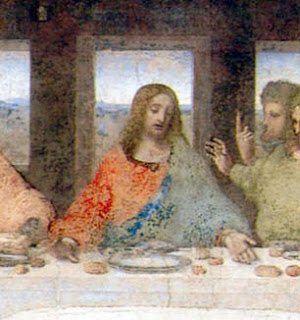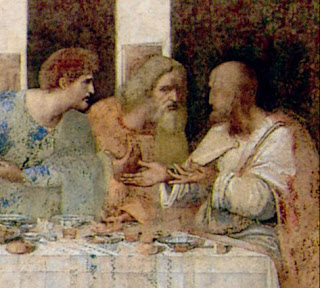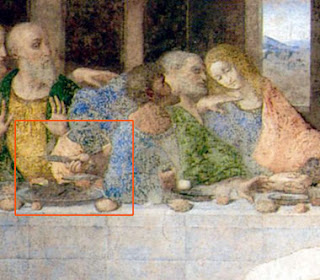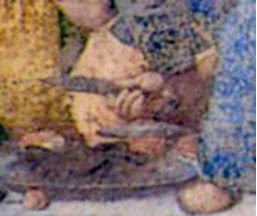Al parecer, el popular cuadro La Última Cena del genio, Leonardo Da Vinci, continúa dando qué hablar. Recientes investigaciones consideran que hay mucho más sobre ese cuadro que aún no se ha dicho y que, salvo antojadizas interpretaciones, falta por decir. Saber por ejemplo, saber si Da Vinci registró en su pintura la amenaza de la Iglesia de Pedro a la Iglesia de Magdalena, o preguntarse, ¿Por qué Leonardo luego de pintar el cuadro viaja Francia, país que se supone también fue visitado por María Magdalena? Conocer si era Leonardo un creyente o un hereje o si eran sus cuadros meras realizaciones artísticas o entroncados laberintos simbólicos. Daremos en este artículo una breve ojeada a estos últimos descubrimientos sobre el cuadro, que en estos tiempos se ha convertido en un símbolo del misterio.

La Última Cena, magistral obra del genio Leonardo Da Vincia, realizada entre los años 1496 y 1497, y ubicada actualmente en Milán, Italia, cuenta de manera espectacular el pasaje bíblico encontrado en Juan 13:21 en donde Jesús anuncia a sus apóstoles que uno de ellos lo traicionaría. La escena por ello, muestra las más diversas reacciones en donde apóstoles se preguntan y cuestionan, con gestos y miradas, quién de ellos sería el que cumpliría tal deplorable destino.
Es en esta complejidad en donde muchos encuentran los supuestos mensajes ocultos que el genio Leonardo habría puesto de manera subrepticia en su pintura. Mensajes que restaban la importancia a la Iglesia Católica como la conocemos y más bien resaltaba otras figuras, hasta hace poco olvidadas en algunos casos o ninguneadas en otros, como los verdaderos pilares del espíritu humano.

Sabido es que para Dan Brown, y otros escritores dedicados al misterio de Leonardo, el cuadro de La Última Cena era una obra que reivindicaba la figura de María Magdalena, mujer que la fe le dio el título de prostituta y que otros afirman, fue en verdad la mujer de Cristo y uno de sus más confiables y luchadores apóstoles. El cuadro, desde el punto de vista de Brown, mostraba a una María Magdalena reemplazando la figura que debía pertenecerle a Juan, el menor. E incluso, la falta de un cáliz sobre la mesa, sugería que sería la Magdalena, el cáliz en sí, es decir, la portadora del hijo de Cristo, o la portadora de la Sangre Real.
Muchos desestiman esta teoría pues suponen que Juan, debido a su juventud, era siempre retratado con facciones femeninas, pues eran mujeres las modelos que servían a los pintores para esos retratos, además, indican, si María Magdalena fuera en verdad la figura que se halla al lado de Cristo, ¿en dónde está Juan?, ¿Acaso Leonardo no le dio importancia a este apóstol?
Pero Brown no es el único, el premiado periodista español, Javier Sierra, publicó hace poco su libro, La Cena Secreta, en donde revela detalles y símbolos en la obra de Leonardo no vistos hasta la fecha.

En principio, hay que destacar que Sierra es un creyente también en la teoría Magdalena del cuadro, él cree que el apóstol Juan representa la figura de María Magdalena y con ella la leyenda que sobre ella se teje. Además indica que era muy común en esa época hallar similitudes entre los rostros de María Magdalena y la figura de Juan, haciendo hincapié en que esos tiempos había un cierto grupo de cristianos que seguían como mentora o maestra a María Magdalena, opacando así la figura de Pedro, el padre del catolicismo.
Pero vayamos a lo que aporta este autor. Sierra hace referencia a un detalle inusual y poco común para la época, esto es que la pintura carece de los clásicos halos de santidad, ni siquiera Jesús, la figura central del cuadro, lleva este halo tan característico en los cuadros del cristianismo. Esto permite al autor dar los primeros indicios de la falta de fe en Leonardo sobre el catolicismo en sí y sobre su rebeldía de pensamiento frente a la doctrina católica.

En este sentido, el autor nota, cómo los dos apóstoles situados al extremo derecho del cuadro, parecen desentenderse de lo que ocurre hacia el lado izquierdo. Efectivamente, las figuras muestran una conversación particular totalmente alejados de las palabras del Cristo. Para esto, Sierra toma como cierta la historia que Leonardo Da Vinci, para retratar a Simón, es decir, al último de los apóstoles, se basó en un busto de Platón, esto que podría parecer un hecho anecdótico tiene un profundo significado puesto que para Sierra, el apóstol que se encuentra junto a Simón, Judas Tadeo, se trataría nada menos que de un autorretrato de Leonardo Da Vinci. De esto infiere que en muchas oportunidades se sabe que Leonardo decía que prefería ser más filósofo que cristiano. Dándole así un toque de cierta herejía en este genio del arte.

Pero hay más, el punto de vista de Sierra se fija ahora al centro de la imagen, en donde, se muestra la figura de Cristo y a su lado izquierdo, luego de la figura de Juan, se encuentra Pedro, es decir, el padre de la Iglesia Católica. Lo curioso de esta escena es que Pedro lleva en una mano que oculta tras su espalda, un cuchillo y con la otra mano, realiza un gesto de “amenaza” la garganta de Juan. Para Sierra, este hecho indica claramente que Leonardo señalaba cómo la Iglesia de Pedro amenaza a la Iglesia de María Magdalena. Es más, un estudio reciente indica cómo Pedro intenta esconder el puñal tras la espalda de Judas, y puede notarse cómo Andrés alza las manos demostrando no tener nada qué ver con aquellas intenciones.

Por último, al autor le parece curioso que luego de terminado el cuadro, Leonardo viajaría a Francia, lugar en donde también se indicaba viajaría María Magdalena llevando consigo al hijo de Jesucristo.
Queda claro con esto la figura de Leonardo Da Vinci, así como su obra, es uno de los fenómenos más importantes en la actualidad. Las ansias de saber qué se esconde detrás de la figura de este genio a sorprendido en general al mercado literario, haciéndolo efectivamente un producto muy rentable para sus propietarios y autores.
Particularmente desestimo que el cuadro de La Última Cena posea algún tipo de inscripción oculta, algún tipo de mapa o manual anticlerical y católico que muchos estiman. Sabido son los miles de borradores que Leonardo usó para crear su cuadro y en ninguno de esos borradores se da indicio de que él quisiera (por lo menos desde el principio) dar cabido a un mensaje oculta a favor de la Iglesia de Magdalena y en contra de la Iglesia Católica.

